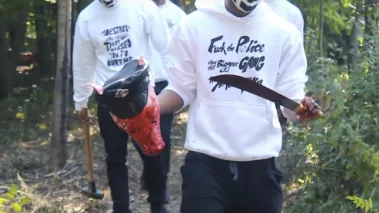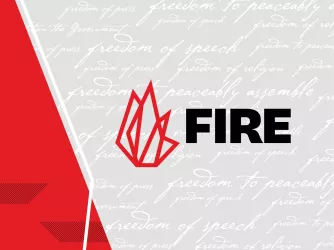Table of Contents
University of Wisconsin–Madison deletes students’ video amid criticism from state senator

It’s not just Washington state legislators calling for unconstitutional restrictions on student speech.
Several students at the University of Wisconsin-Madison have attracted condemnations from a state senator after a copy of their video — critical of law enforcement and President Trump, and depicting violent imagery of a lynching and murder of a police officer — was found on a university-provided Box.com storage site. The university joined law enforcement in recognizing that the video was protected by the First Amendment, but nevertheless deleted the video from the site, citing its connection to T-shirts that the students intend to sell online.
The video was spearheaded by UW-Madison student Eneale Pickett, in conjunction with his line of shirts displaying provocative messages concerning police and racism. It depicts a lynching followed by the beheading of a police officer with a pig’s head, with overlapping audio of both President Trump’s Charlottesville press conference and chants of “Jews will not replace us” from white supremacists at Charlottesville. The student behind the video explained that the video, along with a series of shirts, were intended to start conversations about police brutality and the criminal justice system.
The university reportedly deleted the video and issued a statement explaining that the university allows “everyone to share ideas and political views in exercise of their free speech rights” — but never expressly stated that the video was protected speech. The statement did, however, note that “the university strongly condemns the glorification of violence” in the video and that the university “support[s] our police partners” and rejects “violent imagery as tactics to achieve political objectives.”
Although the university quickly deleted the video, it drew the attention of Sen. Stephen Nass, a frequent critic of the university. Last year, Nass threatened to cut the university’s budget over a “vulgar” essay in a course titled “Problems of American Racial and Ethnic Minorities.” Nass later joined another state legislator’s threats to withhold funding if the university permitted a professor to teach a provocatively-titled course, “The Problem of Whiteness,” exploring questions of “white identity and non-white identity across the globe.” Nass also accused the university of stifling student viewpoints following a student’s attempt to form a pro-white organization, with a spokesman citing the right to express alternative viewpoints.
Nass’ office uploaded the video to its own website and issued a press release claiming credit for having “released” the students’ video, which wasn’t going to be publicly released until today, and urging that the university “must immediately hold these students accountable and that should include an investigation by the local police and the Wisconsin Department of Justice[.]”
Madison police declined, citing the First Amendment. Wisconsin Attorney General Brad Schimel also indicated that the video, while offensive to law enforcement, was protected speech:
The student unquestionably has the First Amendment right to engage in hateful speech like this. 2/
— WI AG Brad Schimel (@WisDOJ) September 21, 2017
Nass went on to tell WAOW-TV:
"Is this free speech? This is not free speech when you're inciting violence. This is like yelling fire in a crowded theater," Nass said.
[...]
"I think the school needs to do everything under their administrative rules. If it were up to me, Steve Nass, I'd kick them out of school, tell them goodbye. You're wasting space for good students who want to obey the law and not incite violence," Nass said.
Nass is incorrect. The video does not amount to unprotected incitement, and its offensiveness to one legislator — or even many or most people — is not a sufficient basis to suppress it.
Speech may only be categorically restricted as “incitement” if it meets an test set forth by Brandenburg v. Ohio (1969). To qualify, it must be “advocacy of the use of force or of law violation . . . directed to inciting or producing imminent lawless action and is likely to incite or produce such action.” Even assuming the video could be said to be endorsing the use of violence, there is no reasonable likelihood that it will cause imminent violence.
Why is this category so seemingly narrow?
Political speech is often imbued with violent rhetoric. Recall, for example, Thomas Jefferson’s now-celebrated letter responding to Shays’ Rebellion, urging that the “tree of liberty must be refreshed from time to time with the blood of patriots & tyrants.” We may find violent imagery distasteful, or believe that its use discredits or distracts from its message. But the notion that the authorities can reliably and fairly determine when message is so fraught with danger that it will inspire an unlawful or violent act at some undefined time and in some unknown place is an obvious mechanism for government to suppress controversial ideas of all sorts. That’s why incitement is a narrow category of speech unprotected by the First Amendment.
The video — and the messages on the shirts — is political speech, which is afforded the highest protection under the First Amendment. Even though speech may be profoundly offensive to some, the First Amendment protects speech that is “provocative and challenging” and “stirs people to anger” as it “strike[s] at prejudices and preconceptions.”
Pickett explained that the video and shirts are intentionally provocative, designed to serve as a basis to discuss the criminal justice system and race:
“Look past the blood on the pig’s head and look deeper inside yourself,” Pickett said. “Because if you feel outrage with the blood on the pig’s head and not Mike Brown laying on the ground for two hours without help, then we need to have a deeper conversation about humanizing black and brown bodies.”
That leaves the matter of whether it was proper for UW-Madison to delete the video. That’s harder to determine.
It’s not precisely clear what types of limitations UW-Madison could place on the type of content students may send using Box.com, but it certainly cannot engage in viewpoint discrimination. The university provides a free Box.com account to every student and faculty member — similar to how universities provide email accounts and internet connections to members of their communities. This “free online file storage and collaboration service” provides students “with a place to store, access, and collaborate on [their] files,” including “with colleagues or clients.”
While the university does not appear to be willing to give in to calls to punish the students here, its willingness to quickly remove student work from a cloud storage system provided to a student is troubling, and there are indicia that the university was motivated by anger over the content of the film. While governments have greater leeway in fashioning regulations on commercial speech, it is not a categorical exception to the First Amendment, and regulations are generally permissible to bar untruthful or misleading commercial speech. “[E]conomic motivation” underlying a message is not enough on its own to characterize it as commercial speech subject to increased government regulation, nor is a reference to a specific product.
The exchange of money in connection with expressive activity does not automatically reduce it to commercial speech alone. Such a rationale would frustrate the ability of artists to create self-sustaining art, be it in the theater, on the screen, or on fabric, and would provide government actors with an avenue to suppress critical, underlying messages.
While there may be commercial aspects to the students’ work, it is mixed with political expression. The video references a website at the end, which will later make available shirts worn by some of the actors, but those shirts also carry political messages intended to start conversation. Although the Box.com terms of service prohibit “commercial purposes that are unrelated to the Educational Institution,” it appears that it was the university itself that deleted the video while condemning its imagery. That suggests not a vigilance against de minimis commercial uses of internet resources, but of eagerness to distance the university from offensive speech, to the students’ detriment.
FIRE has asked the university to provide records relating to its removal of this video, and we’ll continue to monitor this story.
Recent Articles
Get the latest free speech news and analysis from FIRE.

Introducing the SPFI Sentinel: Free speech stories by — and for — student journalists

Why YouTube caving to Trump is cowardly

FIRE statement on the White House’s Compact for Academic Excellence in Higher Education
